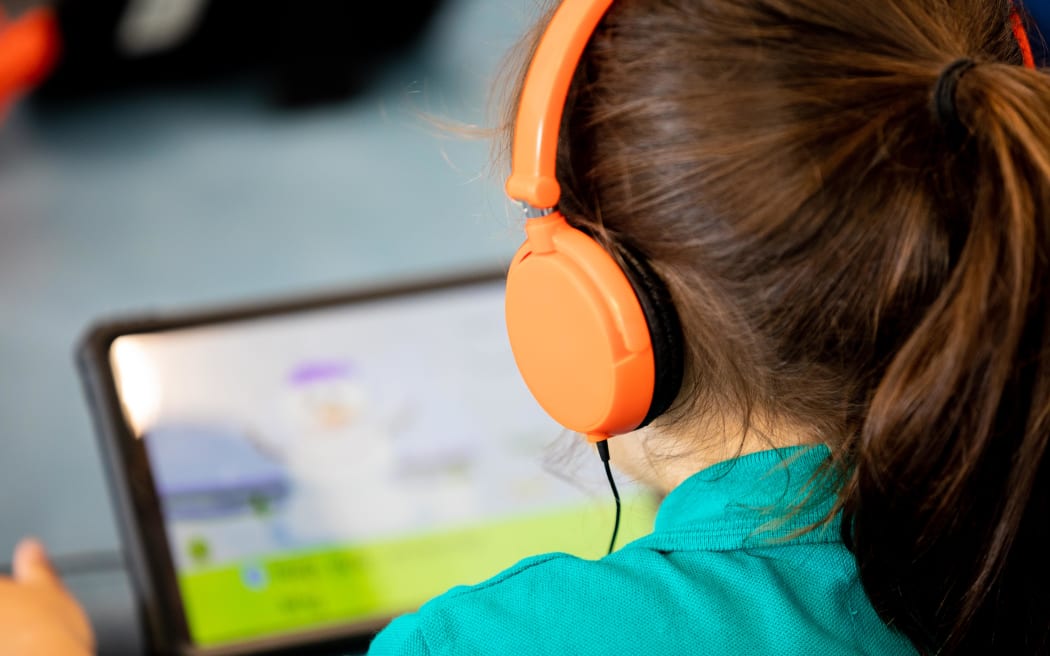
Photo: RNZ / Marika Khabazi
Compared with other countries, New Zealand classrooms have some of the highest rates of device use in the world.
OECD data in 2018 showed that youth in Aotearoa used digital devices (at home and school) for 42 hours per week on average, compared to 35 hours globally, and studies have shown that children's screen use has increased since then, the Auckland University of Technology (AUT) says.
While technology does have benefits for learning, a study published this week in the New Zealand Journal of Physiotherapy highlights the risk of harm for youth.
Auckland University of Technology student and paediatric physiotherapist Julie Cullen told RNZ's Afternoons the narrative review of studies looked at eight different areas of health - including vision, hearing, physical impacts, sleep, mental health, obesity and social impacts.
"While digital technologies can certainly offer opportunities for learning, and other benefits as well, frequent and extended device use is associated with a risk of harm to child and adolescent health and also in numerous areas of health," Cullen said.
"So, time spent using digital technologies affected some areas of health and that's regardless of what content, what kids are doing online."
This included eye health, like myopia and dry eye disease, and noise induced hearing loss linked to volume and length of time.
Whether kids were doing school work or playing games, didn't seem to matter.
But when it came to mental health, wellbeing and cognition, it may.
"On the flip side, there were other areas of health where while time spent on screens is still important, it may be more important what kids are doing online, the content and quality of what they're doing and other factors like their age."
More long-term research into the impact of screen use was needed, Cullen said.
"But it's going to take years, if not decades to have that causation.
"...The Covid-19 pandemic created quite a unique research opportunity to look at the impacts of higher screen use in a way no ethics committee would have ever allowed. They would never have said increase kids screen use and see what happens, but that is what happened with the pandemic.
"There is increased evidence showing there are harmful impacts, compared to what there was a few years ago."
An example was the total myopic shift in children over the pandemic that was directly attributed to increased screen use and reduced time outdoors, she said.
It meant more children were diagnosed with myopia - short-sightedness. As many as three times as many children between six and nine years old were found to have myopia than any of the previous five years.
This had more of an impact for children than adolescents, she said.
"More and more studies have shown that dry eye disease is increasing in our young people, primarily in association with screen use."
Screen use was so prolific that finding causation would take a long time, she said, because it was hard to study people who were not using screens.
While the government was banning phone use in schools and there was recreational screen use guidelines, Cullen said in terms of school screen use that may contribute to frequent and excessive use, nothing was happening in New Zealand.
The average time kids spend using digital technologies in class in other countries was once or twice a week, she said.
Denmark and Sweden, which have similarly high screen use to use, are developing guidelines with a view to encourage a balance of learning on and off screens and to limit screens in the classroom for younger children.
Cullen would like to see recommendations or guidance as well as structured support for teachers and kaiako here.
"We've got primary schools with digital immersion models in New Zealand... we've got young children who do the majority of their learning online, they can be online in their breaks at school, that's before homework and recreational screen use."

